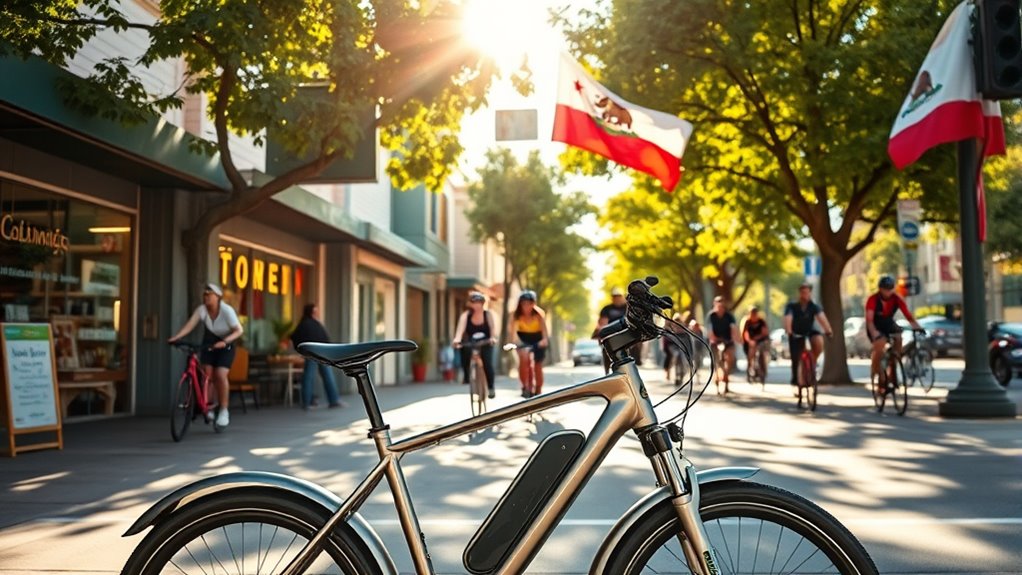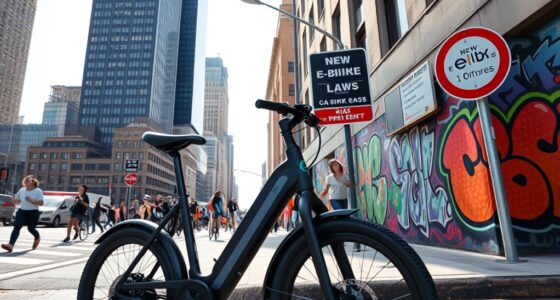California’s new e-bike subsidies help you save money by making electric bikes more affordable. These programs aim to lower upfront costs and promote eco-friendly transportation choices. With the subsidies, you can easily access e-bikes through bike sharing services, which are expanding across cities. They encourage switching from cars or public transit, reducing your carbon footprint. Want to discover how these incentives work and how they can benefit you? Keep exploring to learn more.
Key Takeaways
- California’s new subsidies lower e-bike purchase costs to encourage eco-friendly transportation.
- Subsidies support expanding bike sharing programs with accessible electric bikes across cities.
- They make e-bikes more affordable compared to electric scooters, promoting longer, safer rides.
- The program aims to reduce car reliance, cutting emissions and saving on fuel and parking.
- Additional features like smart technology enhance user experience and promote regular e-bike use.

California has recently launched new e-bike subsidies aimed at making electric bikes more affordable for residents. If you’ve ever contemplated switching from a car or traditional bike, this initiative could be a game-changer. The subsidies are designed to reduce the upfront cost of purchasing an electric bicycle, encouraging more people to choose eco-friendly transportation options. Whether you’re commuting to work, running errands, or just enjoying leisure rides, these incentives could considerably lower your expenses.
One of the key benefits of the new program is its focus on expanding bike sharing options. Many cities already have bike sharing programs that allow you to pick up and drop off bikes at various stations around town. Now, with the added support for e-bikes, you can access electric scooter-like mobility in a more sustainable way. Imagine hopping on an e-bike from a bike sharing station instead of using a ride-hailing app or taking public transit. The subsidies aim to make these e-bikes more accessible, so you don’t have to worry about the high purchase price. Instead, you can enjoy the convenience of electric-assisted rides, whether you’re commuting through city streets or exploring scenic routes.
If you’re new to electric bikes, you might wonder how they compare to electric scooters. While both are electric-powered, e-bikes typically offer a longer range and more comfort for longer distances or rougher terrains. They’re also a safer, more stable option for daily use, especially if you’re planning to ride regularly. The subsidies encourage you to think about these advantages, making e-bikes a practical alternative to electric scooters and other motorized options. Plus, with the growth of bike sharing programs incorporating e-bikes, you can try out different models without committing to a purchase right away.
Another aspect to weigh is how these subsidies could influence your overall transportation habits. You might find yourself leaving your car at home more often, saving money on fuel, parking, and maintenance. E-bikes can be a quick, efficient way to navigate urban areas, especially during peak traffic hours. The availability of bike sharing stations with e-bikes means you don’t need to own one outright—just pick one up when needed and drop it off at your destination. This flexibility makes it easier to integrate e-biking into your daily routine, helping you reduce your carbon footprint and enjoy the benefits of active transportation. Additionally, smart devices like e-bikes designed with innovative technology can further enhance your riding experience.
Frequently Asked Questions
How Long Do the Subsidies Remain Available?
You’re wondering how long the subsidies stay available. The timing window for applying varies, so it’s essential to verify the specific dates set by the program. Typically, there’s an application deadline you need to meet to qualify. These deadlines often fill quickly, so don’t delay. To make certain you don’t miss out, act within the designated period and submit your application before the closing date.
Are There Any Restrictions on E-Bike Brands Eligible for Rebates?
Ever wondered if your favorite e-bike brand’s eligible for rebates? Well, brace yourself—there are brand restrictions and eligibility criteria you must meet. Not all brands qualify, so you can’t just pick any shiny new e-bike and expect a sweet rebate. Check the official guidelines to see which brands are in and which are out. It’s like a club with secret rules—except, you know, the government’s version.
Can I Combine These Subsidies With Other Discounts?
You can often combine e-bike subsidies with other discounts, but it depends on the specific financing options and eligibility criteria. Check if the retailer or program allows stacking discounts, as some may restrict combining offers. Always review the terms carefully to confirm you meet all eligibility criteria and maximize your savings. Doing so helps you get the best deal without violating any rules.
Do These Subsidies Apply to Used E-Bikes?
Think of subsidy eligibility like a garden gate—only certain plants, or in this case, bikes, are allowed through. Unfortunately, used e-bikes often don’t qualify for subsidies, as these programs typically favor new models to encourage eco-friendly purchases. So, if you’re eyeing used e-bikes, you might find that subsidies don’t apply, and you’ll need to cover the full cost without the extra boost.
What Are the Income Limits to Qualify for Subsidies?
You want to know the income thresholds to qualify for e-bike subsidies. Eligibility criteria vary, but generally, income limits are set to assist low- to moderate-income households. In California, these thresholds are based on household size and income level, often aligning with federal poverty guidelines or area median income. Check the specific program details, as they can differ by region and may be updated periodically.
Conclusion
With California’s new e-bike subsidies, you could save money while making eco-friendly travel choices. Imagine Sarah, a commuter who used the subsidy to upgrade her bike and now rides to work every day, saving on gas and reducing her carbon footprint. These incentives make switching to e-bikes more affordable and accessible, helping you contribute to a cleaner environment while enjoying the benefits of faster, healthier travel. Don’t miss out—your greener journey starts today.









